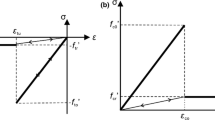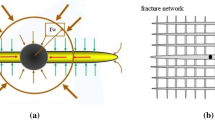Abstract
Casing deformation during hydraulic fracturing is a serious problem in Weirong shale gas field. This study investigated the casing deformation mechanism and the influence of fracability on it based on the shale swelling observed in Weirong shale gas field. First, the characteristics of casing deformation wells in different shale gas fields were analyzed. Then, three-dimensional (3D) geological finite element (FE) models were established to investigate the horizontal differential stress of different wells in Weirong and Yongchuan shale gas fields. Based on the results of the 3D geological FE models, the fracabilities of different wells in both the gas fields were calculated using the analytic hierarchy process. Finally, the relationship between casing deformation and fracability was studied on the basis of shale swelling. Results show that the horizontal differential stress is larger in the wells wherein casing deformation occurred compared with those wherein such a deformation was not observed. Furthermore, casing deformation has a high correlation with fracability. High fracability facilitates the formation of complex fracture networks and produces the stimulated reservoir volume (SRV) area. Simultaneously, a larger horizontal differential stress results in longer fracture extension and larger SRV area. The entry of fracturing fluid at the SRV area can cause shale swelling through the interaction between the clay and fracturing liquid, thereby causing casing deformation. Furthermore, the larger is the length of the SRV area, the higher is the elastic modulus and the higher is the shale swelling, resulting in larger casing stress. The findings obtained herein provide a new understanding of the casing deformation in the Weirong shale gas field. In addition, these findings could explain why casing deformation is more common in the Weirong field than in the Yongchuan field.























Similar content being viewed by others
References
Bao X, Eaton DW (2016) Fault activation by hydraulic fracturing in western Canada. Science 354(6318):1406–1409
Cai T, Bian X, Wang H, Li S, Jia C, Liu H, Sun H (2017) Volume fracturing of deep shale gas horizontal wells. Nat Gas Ind 37(01):90–96
Cai X, Zhao P, Gao B, Zhu T, Tian L, Sun C (2021) Sinopec’s shale gas development achievements during the “Thirteenth Five-Year Plan” period and outlook for the future. Oil Gas Geol 42(01):16–27
Cui C, Dong Z, Wu D (2019) Rock mechanics study and fracability evaluation for Longmaxi Formation of Baojing block in Hunan province. Nat Gas Geosci 30(05):626–634
Guo J, Luo B, Zhu H, Wang Y, Lu Q, Zhao X (2015) Evaluation of fracability and screening of perforation interval for tight sandstone gas reservoir in western Sichuan Basin. J Nat Gas Sci Eng 25:77–87
Ju W, Jiang B, Qin Y, Wu C, Li M, Xu H, Wang S (2020) Characteristics of present-day in-situ stress field under multi-seam conditions: Implications for coalbed methane development. J China Coal Soc 45(10):3492–3500
Lai F, Luo H, Qin D, Xia W, Gong D (2018) Crushability evaluation of shale gas reservoir based on analytic hierarchy process. Spec Oil Gas Reservoirs 25(03):154–159
Li H, Li Z, Li G, Yu H, Jiang Z, He L, Guo B, Dong M (2020) Casing deformation mechanisms of horizontal wells in Weirong shale gas field during multistage hydraulic fracturing. J Nat Gas Sci Eng 84:103646
Li Z, Li H, Li G, Yu H, Jiang Z, Liu H, Hu S, Tang B (2021) The influence of shale swelling on casing deformation during hydraulic fracturing. J Petrol Sci Eng 205:108844
Lian Z, Yu H, Lin T, Guo J (2015) A study on casing deformation failure during multi-stage hydraulic fracturing for the stimulated reservoir volume of horizontal shale wells. J Nat Gas Sci Eng 23:538–546
Liu J, Ding W, Yang H, Wang R, Yin S, Li A, Fu F (2017) 3D geomechanical modeling and numerical simulation of in-situ stress fields in shale reservoirs: a case study of the lower Cambrian Niutitang formation in the Cen’gong block, South China. Tectonophysics 712–713:663–683
Liu K, Taleghani AD, Gao D (2019) Calculation of hydraulic fracture induced stress and corresponding fault slippage in shale formation. Fuel 254:115525
Ma X, Xie J (2018) The progress and prospects of shale gas exploration and development in southern Sichuan Basin, SW China. Petrol Explor Dev Online 45(1):172–182
Mainguy M (2016) Monitoring shear deformations above compacting high-pressure high-temperature reservoirs with calliper surveys. Int J Rock Mech Min Sci 86:292–302
Mejia Sanchez EC, Rueda Cordero JA, Roehl D (2020) Numerical simulation of three-dimensional fracture interaction. Comput Geotech 122:103528
Meyer JJ, Gallop J, Chen A, Reynolds S, Mildren S (2018) Can seismic inversion be used for geomechanics a casing deformation example. SPE/AAPG/SEG Unconventional Resources Technology Conference, 23–25 July, Houston, Texas, USA
Qian B, Yin C, Li Y, Xu B, Qin G (2015) Diagnostics of casing deformation in multi-stage hydraulic fracturing stimulation in lower Silurian marine shale play in Southwestern China. Unconventional Resources Technology Conference, 20–22 July, San Antonio, Texas, USA
Ren H, Liu C, Liu W, Yang X, Li W (2020) Stress field simulation and fracture development prediction of the Wufeng Formation-Longmaxi Formation in the Fushun-Yongchuan Block, Sichuan Basin. J Geomech 26(1)
Sugden C, Johnson J, Chambers M, Ring G, Suryanarayana PV (2012) Special considerations in the design optimization of high rate, multistage fractured shale wells. IADC/SPE Drilling Conference and Exhibition, San Diego, California, USA
Sui L, Ju Y, Yang Y, Yang Y, Li A (2016) A quantification method for shale fracability based on analytic hierarchy process. Energy 115:637–645
Taleghani AD, Olson JE (2011) Numerical modeling of multistranded-hydraulic-fracture propagation: accounting for the interaction between induced and natural fractures. SPE J 16(3):575–581
Tian Z, Shi L, Qiao L (2015) Research of and countermeasure for wellbore integrity of shale gas horizontal well. Nat Gas Ind 35(9):70–76
Wang H (2019) Hydraulic fracture propagation in naturally fractured reservoirs: complex fracture or fracture networks. J Nat Gas Sci Eng 68:102911
Wang K, Zhang H, Zhang R, Wang J, Liu C, Yang X (2017) Analysis and numerical simulation of tectonic stress field in the Dabei gas field, Tarim basin. Acta Geol Sin 91(11):2557–2572
Xi Y, Li J, Liu G, Cha C, Fu Y (2018) Numerical investigation for different casing deformation reasons in Weiyuan-Changning shale gas field during multistage hydraulic fracturing. J Petrol Sci Eng 163:691–702
Xi Y, Li J, Liu G, Zeng Y, Li J (2019a) Overview of casing deformation in multistage fracturing of shale gas horizontal wells. Spec Oil Gas Reservoirs 26(1):1–6
Xi Y, Li J, Zha C, Guo B, Liu G (2019b) A new investigation on casing shear deformation during multistage fracturing in shale gas wells based on microseism data and calliper surveys. J Petrol Sci Eng 180:1034–1045
Yan W, Zou L, Li H, Deng J, Ge H, Wang H (2017) Investigation of casing deformation during hydraulic fracturing in high geo-stress shale gas play. J Petrol Sci Eng 150:22–29
Yang H, Li J, Liu G, Li Y, Xi Y, Tang G (2017) Quantitative evaluation of shale fracability based on logging data. Fault-Block Oil Gas Field 24(03):382–386
Yin F, Gao D (2015) Prediction of sustained production casing pressure and casing design for shale gas horizontal wells. J Nat Gas Sci Eng 25:159–165
Yin F, Han L, Yang S, Deng Y, He Y, Wu X (2018) Casing deformation from fracture slip in hydraulic fracturing. J Petrol Sci Eng 166:235–241
Yu H, Taleghani AD, Lian Z, Lin T (2019) Impact of asymmetric stimulated rock volume on casing deformation in multi-stage fracturing; a case study. SPE Annual Technical Conference and Exhibition, Calgary, Alberta, Canada
Zhang H, Chen Z, Shi L, Xiang D, Wang S, Wang Q, Zhou L (2018) Mechanism of how fluid passage formed and application in Sichuan shale gas casing deformation analysis. Drill Prod Technol 41(04):8–11
Acknowledgements
Our research is supported by the National Natural Science Foundation of China (No.51904264, No.51674217), China Postdoctoral Science Foundation (No.2018M643792XB, No.2020M673577XB), and Postgraduate Innovation Foundation of SWPU (No. 2020cxyb051).
Author information
Authors and Affiliations
Contributions
Ze Li: methodology, numerical simulation, writing; Gao Li: supervision, methodology; Hongtao Li: supervision, numerical simulation; Hao Yu: writing—review and editing, numerical simulation; Long He: data curation; Zujun Jiang: validation.
Corresponding authors
Ethics declarations
Conflict of interest
The authors declare no conflict of interest.
Additional information
Responsible Editor: Santanu Banerjee
Rights and permissions
About this article
Cite this article
Li, Z., Li, G., Li, H. et al. A novel investigation on casing deformation during hydraulic fracturing in the Weirong shale gas field, Sichuan basin, China. Arab J Geosci 14, 2857 (2021). https://doi.org/10.1007/s12517-021-09040-9
Received:
Accepted:
Published:
DOI: https://doi.org/10.1007/s12517-021-09040-9




